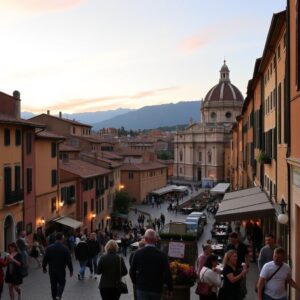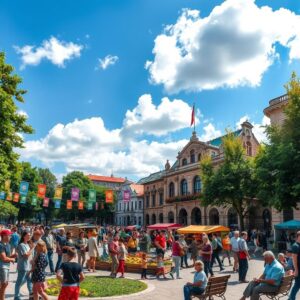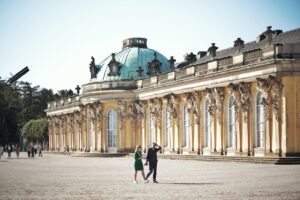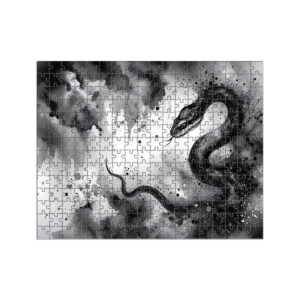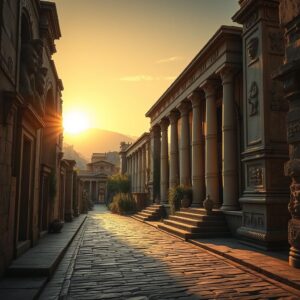
Explore & Play
Discover interesting topics and solve the accompanying crossword puzzle.
Danish city crossword | Denmark’s architectural gems
Table of Contents
At the beginning of this blog post, you’ll find the Danish city crossword. Feel free to solve it first and then explore the article to deepen your knowledge about Denmark’s architectural wonders. If you’re not very familiar with the topic, you can read the article first to gain some insights and then return to the crossword to test what you’ve learned.
Danish City Crossword
You can either fill in the crossword puzzle directly on this page or click the button in the bottom right corner to print it for free.
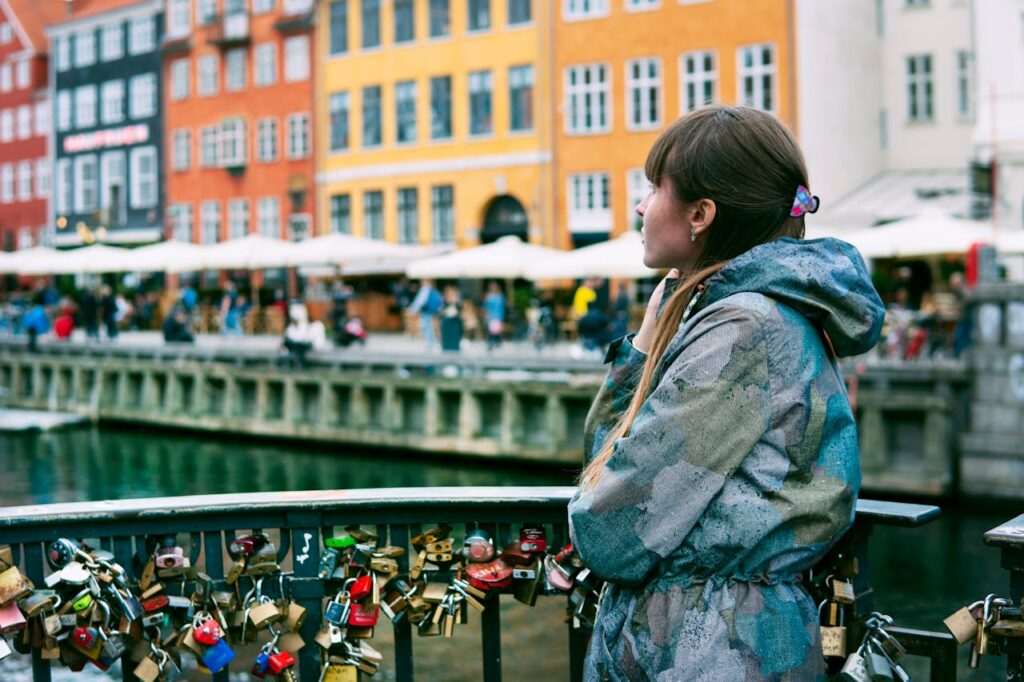
Denmark’s Diverse Architectural Legacy
From medieval castles and quaint timbered houses to sleek modern designs, Denmark’s cities showcase a remarkable architectural journey through time. Each city tells its story through unique buildings and landmarks, reflecting the nation’s vibrant history, innovative spirit, and cultural values. This article takes you on a city-by-city exploration of Denmark’s architectural wonders, revealing why these cities are architectural gems and why you should visit them.
And for a bit of fun, don’t forget to challenge yourself with the crossword puzzle at the end—it’s a playful way to test your knowledge about these cities and their architectural highlights!
Timeless Capitals: Iconic Architecture in Copenhagen and Aarhus
Copenhagen: Where History Meets Modernity
Copenhagen, Denmark’s vibrant capital, is a stunning fusion of old-world charm and cutting-edge modernity. The city’s architectural landscape is a reflection of its rich history, evolving over centuries while embracing contemporary innovation. A walk through Copenhagen feels like an architectural journey through time, from medieval castles to the most avant-garde designs of the 21st century.
One of Copenhagen’s most iconic landmarks is Nyhavn, the historic harbor lined with brightly colored buildings and wooden ships. This picturesque waterfront, dating back to the 17th century, is a testament to Denmark’s maritime heritage. The buildings, once used by sailors and traders, now house charming cafes and restaurants, offering a perfect blend of history and modern life.
Not far from Nyhavn, you’ll find the Royal Danish Opera House, a striking example of modern architecture. Opened in 2005, it was designed by the renowned architect Henning Larsen and has quickly become one of Copenhagen’s most iconic buildings. Its bold, minimalist design stands in stark contrast to the more traditional structures around it, yet it complements the city’s skyline beautifully. The Opera House sits on the waterfront, with spectacular views of the Copenhagen harbor and the Amalienborg Palace, the residence of the Danish royal family.
Further along the city, Tivoli Gardens stands as a whimsical representation of Danish design, blending nature, entertainment, and architecture in a magical setting. Opened in 1843, the park is one of the world’s oldest amusement parks and continues to captivate visitors with its intricate pavilions, fountains, and decorative features, blending traditional Danish design elements with a modern approach to leisure and entertainment.
Aarhus: Denmark’s Cultural Hub
Aarhus, Denmark’s second-largest city, is often considered the country’s cultural and architectural heartbeat. Here, modern architecture meets historic charm in a way that feels both natural and exciting. The city is home to some of Denmark’s most innovative buildings, reflecting a blend of the old and new in one dynamic urban environment.
The ARoS Aarhus Art Museum is a prime example of this blend. Its striking architecture is complemented by Your Rainbow Panorama, a 150-meter-long circular walkway made entirely of colored glass. The panoramic view from the top of the museum is breathtaking, offering a unique experience that showcases Aarhus’s commitment to creativity and modern design. The building itself, with its bold geometric lines and expansive glass façades, is a masterpiece of contemporary architecture that stands proudly in the heart of the city.
Another architectural wonder in Aarhus is Dokk1, the city’s largest library and cultural center, located at the waterfront. Dokk1’s design is as modern as it gets, with a sleek, minimalist exterior and a spacious interior that fosters creativity and learning. The building’s multifunctional spaces host a variety of events and exhibitions, making it a hub for both locals and tourists.
The city’s historic district, known as the Latin Quarter, offers a different architectural experience. Here, cobbled streets are lined with charming half-timbered houses dating back to the 16th century, offering a beautiful contrast to the sleek, contemporary structures. The area exudes a timeless charm, with its quaint shops, cozy cafes, and cobbled alleyways that transport visitors to a bygone era.
Castles and Cathedrals: Relics of a Regal Past
Hillerød: Frederiksborg Castle’s Grandeur
Frederiksborg Castle, located in the picturesque town of Hillerød, is one of Denmark’s most magnificent historical landmarks. This Renaissance-style castle, built in the early 17th century, is a striking example of the opulence and grandeur of Denmark’s royal past. Situated on a series of islands on Lake Slots, the castle’s impressive architecture and beautiful gardens make it a must-visit destination for anyone interested in Danish history and design.
The castle’s design, by architect Hans van Steenwinckel the Younger, features intricate brickwork, elegant towers, and vast wings that surround an ornate courtyard. Inside, the rooms are just as impressive, with lavish furniture, tapestries, and portraits of Danish kings and queens. The Hall of Mirrors, with its majestic chandeliers and gilded walls, is particularly stunning, evoking the lavish style of European palaces during the period.
The castle is not just a beautiful historical site; it also houses the Museum of National History, where visitors can explore exhibitions about Denmark’s royal history and its impact on the country’s development. The surrounding Frederiksborg Gardens are equally stunning, with their formal, symmetrical designs, fountains, and statues reflecting the Renaissance ideals of harmony between architecture and nature.
Roskilde: A Medieval Cathedral City
Roskilde, a city located just a short distance from Copenhagen, is home to one of Denmark’s most important historical landmarks: the Roskilde Cathedral. A UNESCO World Heritage Site, this Gothic cathedral has been the final resting place of many Danish kings and queens, making it a place of immense historical and cultural significance.
The cathedral’s architecture is an exceptional example of Gothic style, with its soaring spires, intricate stone carvings, and colorful stained glass windows. The building’s vast interior is equally impressive, with its high vaulted ceilings and delicate woodwork. The Royal Tombs inside the cathedral are a poignant reminder of Denmark’s royal lineage, and the cathedral’s design itself is an enduring symbol of Denmark’s medieval past.
Roskilde’s cathedral is not just an architectural treasure but also a center of Danish history and religion. For centuries, it has been the site of royal coronations, weddings, and funerals, making it a symbol of continuity in Denmark’s royal traditions. Visitors can also explore the surrounding Roskilde Viking Ship Museum, where preserved Viking ships are on display, adding to the city’s reputation as a place where the past is deeply honored and carefully preserved.
Viborg: Where the Middle Ages Come to Life
Viborg is another city where Denmark’s medieval past can be explored through its architecture. The Viborg Cathedral, with its imposing Romanesque design, stands at the heart of the city and is one of Denmark’s oldest and most important religious buildings. The cathedral’s construction dates back to the 12th century, and its solid stone structure, intricate frescoes, and majestic towers continue to awe visitors.
Inside, the cathedral’s magnificent altar and stained glass windows tell the story of Denmark’s medieval religious life, while the soaring ceilings and massive columns evoke a sense of grandeur and awe. The cathedral’s crypt, which houses the tombs of several bishops, further emphasizes the importance of this site in Danish religious and political history.
Viborg itself is a charming city, with its cobbled streets and medieval houses offering a glimpse into life during the Middle Ages. Many of the buildings have been preserved, and the city’s town square remains one of the best examples of medieval urban planning in Denmark. Viborg’s combination of historical architecture, religious heritage, and natural beauty makes it a truly special place to visit for those interested in Denmark’s past.
Coastal Charms: Architectural Highlights by the Sea
Skagen: Where the Sea Meets Art and Architecture
Skagen, Denmark’s northernmost town, is a place where the windswept coastlines and colorful fishing villages meet some of the most unique architectural styles in the country. Known for its stunning landscapes and vibrant art scene, Skagen has long been a source of inspiration for painters, especially during the late 19th and early 20th centuries when the Skagen Painters made the town famous. The town’s architecture is just as captivating as its natural beauty, blending traditional Scandinavian elements with the spirit of artistic expression.
One of Skagen’s most iconic landmarks is Skagen Harbor, where the quaint, yellow-painted houses with white trimmings line the shore, reflecting the area’s maritime heritage. These buildings, many of which date back to the late 1800s, evoke the warmth and simplicity of Scandinavian design, offering an inviting atmosphere for visitors. The harbor’s working fishing boats and colorful nets add to the town’s charm, where art and architecture coexist in perfect harmony.
The Skagens Museum, housed in a former fisherman’s house, is a key cultural attraction, showcasing the works of the town’s famous artists and offering visitors an insight into Skagen’s unique history. As you walk through the narrow streets of the town, you’ll notice the beautiful wooden houses with steep roofs, some adorned with intricate decorative elements typical of Denmark’s coastal architectural style. These structures, originally built by sailors and merchants, are a perfect example of how the architecture of a seaside town can reflect the lifestyle and traditions of its people.
Another architectural gem of Skagen is Grenen, the northernmost point of Denmark, where the North Sea and the Baltic Sea meet. The natural phenomenon of the two seas converging creates dramatic waves and a striking visual contrast that has inspired both artists and architects alike. The Skagen Lighthouse, with its bold red-and-white stripes, stands tall against the landscape and is an iconic symbol of the town’s maritime connection.
Bornholm: A Seaside Paradise with Unique Architecture
Bornholm, an island in the Baltic Sea, is renowned for its stunning coastal landscapes and distinctive architectural style. The island’s architecture is characterized by its use of local materials, including granite, which is abundant on the island, and the traditional thatched-roof cottages that dot the landscape. Bornholm’s coastal towns, such as Svaneke and Gudhjem, offer a picturesque glimpse into a more rustic, traditional Denmark, with whitewashed cottages, cobbled streets, and charming harbor areas that perfectly capture the essence of Scandinavian coastal life.
One of the island’s architectural highlights is Hammershus, the largest medieval fortress in northern Europe. Sitting atop a cliff overlooking the Baltic Sea, Hammershus offers dramatic views and showcases the medieval military architecture of the region. The fortress, which dates back to the 13th century, has been partially restored and now serves as a museum, offering visitors a chance to explore Denmark’s past and its connections to the sea. The surrounding landscape, with its rugged coastline and dense forests, adds to the atmosphere of this historical site, making it a must-see for anyone visiting Bornholm.
Bornholm is also known for its modern architecture, particularly in its approach to sustainable building practices. The island has embraced eco-friendly design, with many new buildings incorporating renewable energy sources and environmentally conscious materials. The Bornholm Art Museum, perched on a cliff with a panoramic view of the sea, is an excellent example of this blend of modern architecture and natural beauty. The museum’s clean, contemporary design contrasts beautifully with the island’s more traditional structures, creating a harmonious balance between the old and the new.
Urban Artistry: Modern Architecture in Smaller Cities
Odense: The Heart of Danish Innovation
Odense, Denmark’s third-largest city and the birthplace of Hans Christian Andersen, is known for its rich cultural history, but in recent years, the city has also become a hub for modern architecture. The city’s embrace of contemporary design is evident in its many new developments, including cultural centers, residential buildings, and public spaces. Odense offers a striking juxtaposition between the old and the new, with its medieval town center filled with cobblestone streets and charming houses, and its modern buildings that push the boundaries of architectural innovation.
A standout example of modern design in Odense is the Odense Concert Hall, a state-of-the-art facility that hosts a variety of performances, from classical concerts to contemporary music and theater. The concert hall’s sleek, geometric design features large expanses of glass that allow natural light to flood the interior, creating an open and inviting space. The building’s minimalist aesthetic is complemented by its natural surroundings, with the nearby Odense River providing a serene backdrop to this architectural marvel.
Another key architectural highlight in Odense is the Brandts Museum of Art, housed in a former industrial complex that has been transformed into a vibrant cultural venue. The museum’s renovation blends the building’s industrial past with modern architectural features, such as steel beams, glass walls, and open courtyards. The combination of old and new is a testament to Odense’s ability to honor its heritage while embracing the future.
Vejle: The Intersection of Nature and Design
Vejle, a smaller city in Denmark, may not be as internationally renowned as Copenhagen or Aarhus, but it is an excellent example of how modern architecture can harmonize with the natural environment. Nestled between hills and the fjord, Vejle’s landscape is an essential component of its architectural identity. The city is known for its sustainable and environmentally conscious buildings that make use of local materials and design elements that complement the surrounding landscape.
One of the most striking examples of modern architecture in Vejle is The Vejle Fjord Bridge. This cable-stayed bridge, which spans the fjord, is not just a functional piece of infrastructure but an elegant work of art in itself. The sleek lines of the bridge, designed to mimic the natural curves of the surrounding hills, make it a striking feature of the city’s skyline. The bridge, along with the nearby Vejle River, contributes to the city’s reputation for architectural ingenuity and environmental integration.
In addition to the Fjord Bridge, Vejle is home to several contemporary residential complexes that feature innovative designs. These buildings often incorporate green roofs, solar panels, and natural building materials, reflecting the city’s commitment to sustainability. The architecture of Vejle is a testament to how urban design can coexist with nature, creating a harmonious living environment that is both functional and beautiful.
Vejle also embraces the idea of creating public spaces that invite people to engage with their surroundings. The Vejle River Park, with its winding pathways, green spaces, and water features, is an example of how the city integrates nature into its urban planning. The park offers a tranquil escape for locals and visitors alike, while its design showcases the intersection of modern architecture and environmental consciousness.
Preserving Heritage: Medieval and Timbered Houses
Medieval Marvels: The Historic Streets of Roskilde and Viborg
Denmark is rich with medieval history, and its preservation is integral to understanding the evolution of Danish architecture. Roskilde and Viborg are two cities where medieval heritage is brought to life, offering visitors a window into the past. These cities boast an array of medieval buildings, from majestic cathedrals to charming streets lined with half-timbered houses, which have stood the test of time.
Roskilde, a city just outside of Copenhagen, is perhaps best known for the Roskilde Cathedral, a UNESCO World Heritage Site. This Gothic masterpiece, constructed in the 12th century, is a symbol of Danish royalty and history. The cathedral is home to the tombs of many Danish kings and queens, and its stunning architecture, with intricate stone carvings and soaring spires, draws visitors from all over the world. The surrounding medieval town of Roskilde adds to the city’s historic charm, with narrow cobbled streets and timber-framed houses that offer a sense of what life was like centuries ago.
Viborg, located in Jutland, is another key city in Denmark’s medieval landscape. Its charming Viborg Cathedral, with its Romanesque architecture and imposing twin towers, sits at the heart of the city. The surrounding streets feature timber-framed buildings that have been carefully preserved, offering a glimpse into how medieval towns were once constructed. Many of these houses date back to the 16th century, showcasing the traditional half-timbered technique where wooden frames are filled with brick or plaster. These buildings often feature steep, gabled roofs, ornate carvings, and beautiful wooden window shutters, adding character to the city’s streetscape.
The preservation of these medieval buildings in both Roskilde and Viborg is a testament to Denmark’s commitment to safeguarding its architectural heritage. These historic structures not only serve as reminders of Denmark’s royal past but also provide insight into traditional building techniques that have been passed down through generations. The careful restoration of these sites allows modern visitors to appreciate the craftsmanship and architectural ingenuity of the medieval period.
Timbered Houses: A Symbol of Denmark’s Rural Past
The half-timbered house, or bindingsværk, is a quintessential feature of Denmark’s rural architecture. These charming structures, characterized by exposed wooden beams and infill walls made of brick, stone, or plaster, have been a staple of Danish design for centuries. The use of timber in construction dates back to the Middle Ages, when it was a readily available building material in Denmark’s forests. Over time, the half-timbered house became synonymous with the Danish countryside, and today, these houses remain an important part of the country’s architectural heritage.
In rural areas of Denmark, towns like Middelalderbyen in Helsingør and Mønsted still feature well-preserved examples of timbered houses. These buildings, with their distinctive wooden framework and quaint facades, offer a glimpse into Denmark’s agricultural past. The half-timbered houses were typically built by local craftsmen, and their design was often a reflection of the region’s climate and resources. For example, houses in coastal areas often feature steep, sloping roofs to help shed the heavy snowfall during winter, while those in more sheltered locations might have broader, lower roofs for better insulation.
Many of Denmark’s timbered houses are still inhabited, and their preservation is vital for understanding the cultural and architectural evolution of the country. Modern conservation efforts focus on maintaining these homes’ original charm while ensuring they meet the needs of contemporary living. The combination of historical significance and modern functionality makes Denmark’s timbered houses a perfect example of how architecture can bridge the past and the present.
Island Inspirations: Architectural Wonders Beyond the Mainland
Møn: A Seaside Paradise with Rich Architectural Heritage
Møn, a tranquil island in the Baltic Sea, is renowned for its natural beauty, but it also offers a fascinating architectural heritage. The island’s rolling hills, sandy beaches, and dramatic white cliffs provide a stunning backdrop for its historic buildings, which range from ancient churches to picturesque farmhouses. Møn is perhaps best known for its ancient Møn Church, a striking example of Gothic architecture that dates back to the 13th century. The church is built from local limestone, and its intricate carvings and tall spires reflect the island’s deep connection to both its religious and cultural history.
In addition to Møn Church, the island boasts several traditional landbrugshuse (farmhouses) that showcase Denmark’s rural architectural style. These houses, often made of wood and stone, feature thatched roofs and whitewashed exteriors that reflect the simplicity and functionality of rural life. The charm of Møn’s architecture lies in its ability to blend seamlessly with its natural surroundings, creating an environment where both the built and natural landscapes complement one another.
Møn is also home to Geocenter Møn, a modern architectural marvel that celebrates the island’s geological history. The center, designed with sustainable principles in mind, integrates with the landscape, offering stunning views of the cliffs and surrounding countryside. The center’s contemporary design, with its use of natural materials such as wood and stone, complements the island’s more traditional structures, creating a harmonious blend of the old and the new.
Funen: A Blend of Classic and Contemporary Designs
Funen, Denmark’s second-largest island, is a place where architectural history meets modern design. The island is home to the city of Odense, the birthplace of Hans Christian Andersen, which features both charming medieval buildings and cutting-edge modern architecture. However, the island’s lesser-known towns and rural areas also offer a wealth of architectural treasures.
One of the most striking architectural features of Funen is the island’s many castles and manor houses. Egeskov Castle, located on the southern part of the island, is one of the best-preserved Renaissance castles in Europe. Its remarkable moat, gardens, and intricate brickwork showcase the grandeur of the Danish Renaissance period, while the castle’s many rooms and exhibitions provide a fascinating glimpse into Denmark’s royal past. The surrounding grounds, with their elaborate gardens and nature trails, also highlight how landscape architecture was integrated into the design of Denmark’s historical homes.
Beyond its castles, Funen is home to many picturesque villages with charming timber-framed houses. These traditional homes, with their gabled roofs and vibrant, colorful facades, reflect the island’s agricultural heritage. The use of local materials such as limestone and timber gives Funen’s villages a rustic, inviting feel, and the preservation of these buildings allows visitors to experience the island’s architectural past firsthand.
In contrast, Funen also embraces modern architecture, with cities like Odense showcasing innovative buildings such as the Odense Concert Hall, a stunning example of contemporary design that blends glass, steel, and concrete to create a striking structure that complements the city’s cultural identity. These modern buildings reflect Denmark’s commitment to sustainability, with many incorporating green roofs, solar panels, and energy-efficient systems.
Urban Development and Innovation
Copenhagen: A Vision of Sustainable Urban Growth
As Denmark’s capital and one of the most forward-thinking cities in Europe, Copenhagen stands at the forefront of urban development and innovation. The city has long been recognized for its commitment to sustainability, green building practices, and innovative solutions to urban challenges. In recent years, Copenhagen has embraced modern architectural designs that emphasize environmental consciousness while maintaining the city’s rich architectural heritage.
One of Copenhagen’s most notable achievements in sustainable urban design is the Copenhagen Harbor Front Redevelopment. This ambitious project transformed a formerly industrial harbor area into a vibrant, mixed-use urban district that prioritizes green spaces, eco-friendly buildings, and waterfront access. One of the standout features of the redevelopment is the Copenhagen Opera House, an iconic modern structure that sits on the banks of the harbor, with views across the water to the historic city center. The building’s sleek design, with its sweeping lines and glass façade, contrasts beautifully with the classical architecture of Copenhagen’s older buildings while reflecting the city’s forward-thinking ethos.
The city’s commitment to innovation is also seen in its sustainable transportation network. Copenhagen is known for being one of the most bike-friendly cities in the world, with an extensive network of cycling paths and bike-sharing programs that make commuting environmentally friendly and efficient. The integration of cycling infrastructure into the urban landscape has encouraged citizens to embrace a greener mode of transport, reducing the city’s carbon footprint.
Copenhagen also leads the way in sustainable architecture with projects like The Cactus Tower, a mixed-use building that incorporates green roofs, solar panels, and rainwater harvesting systems. Designed to be a model of urban sustainability, the tower stands as a testament to the city’s dedication to reducing its environmental impact while fostering modern urban living. Through these and other initiatives, Copenhagen is shaping the future of urban development, where sustainability and innovation are prioritized to create a livable, forward-thinking city.
Aarhus: Blending Modern Innovation with Historical Architecture
In Denmark’s second-largest city, Aarhus, urban development has also taken a creative turn. The city’s approach to innovation in architecture combines sleek, modern designs with a respect for its historical roots. Aarhus is home to some of Denmark’s most cutting-edge buildings, including the ARoS Aarhus Art Museum, which boasts a striking rainbow-colored rooftop walkway that offers visitors a panoramic view of the city. This modern architectural marvel contrasts with the city’s medieval and classical buildings, yet they exist in harmony, creating a unique architectural landscape.
The city’s commitment to sustainability is also evident in its green buildings and urban spaces. For example, Dokk1, a library and cultural center, is designed to be a flexible and sustainable building that serves as both a public space and a symbol of modern urban development. The building’s innovative use of natural materials, energy-efficient features, and cutting-edge design make it an exemplary model for sustainable architecture in urban areas. Aarhus is also known for its well-planned green spaces, such as the Tivoli Friheden park, where nature and architecture coexist seamlessly, offering city dwellers a place to relax and escape the hustle and bustle of urban life.
Aarhus’s development is not just about modernity and sustainability—it also focuses on revitalizing older parts of the city, like the Latinerkvarteret (Latin Quarter). This area, with its narrow cobbled streets and charming historic buildings, has been transformed into a vibrant cultural hub that blends old and new. The careful restoration of these buildings has preserved the city’s historic charm while incorporating modern conveniences to meet the needs of contemporary life.
Through a balance of innovation and preservation, Aarhus has proven itself as a city where urban development and architectural creativity come together, enhancing the quality of life for its residents while showcasing Denmark’s commitment to sustainable design.
Hidden Gems: Lesser-Known Cities with Unique Architecture
Odense: A Mix of Old-World Charm and Modern Design
While Odense, Denmark’s third-largest city and the birthplace of Hans Christian Andersen, may not be as well-known as Copenhagen or Aarhus, it is home to a wealth of unique architecture that offers a different perspective on Danish design. The city is a blend of historical buildings, including the charming Odense Cathedral, and modern urban developments that make it a hidden gem for architecture lovers.
The Odense Cathedral, built in the Gothic style, is a magnificent example of medieval architecture, with its soaring spires and intricate stonework. It is one of the most iconic buildings in the city and is a must-see for anyone visiting Odense. However, the city’s charm lies in its ability to combine old-world architecture with contemporary design. The Hans Christian Andersen Museum, for example, is housed in a modern building that contrasts with the historic surroundings. Its clean lines and minimalist design showcase how modern architecture can coexist with the old while highlighting the legacy of one of Denmark’s most famous writers.
In addition to its historic landmarks, Odense is also home to several architectural treasures that reflect the city’s commitment to sustainability and innovation. The Odense Zoo, for instance, features eco-friendly buildings designed to blend seamlessly with the surrounding landscape. These structures use natural materials and energy-efficient technologies to create a sustainable environment for both animals and visitors. Odense’s dedication to preserving its heritage while embracing modern architectural trends makes it a city worth exploring for those interested in unique and innovative design.
Aalborg: Industrial Charm Meets Contemporary Creativity
- Aalborg*, located in northern Jutland, is another lesser-known city in Denmark that boasts a fascinating mix of architectural styles, from industrial warehouses to modern cultural centers. The city’s transformation from an industrial hub to a vibrant cultural center is reflected in its architecture. One of the best examples of this transformation is the Utzon Center, named after the famous Danish architect Jørn Utzon, best known for designing the Sydney Opera House. The center’s modern, minimalist design blends seamlessly with the city’s industrial past, offering a space for exhibitions, workshops, and cultural events.
Aalborg also features a number of old warehouses and factories that have been repurposed for modern use. The Kulturhus (Cultural House), housed in a former tobacco factory, is a prime example of how Aalborg is reimagining its industrial past. The building’s exposed brick walls, large windows, and open spaces create a dynamic environment that fosters creativity and artistic expression. These converted buildings add character to the city and show how adaptive reuse can play a vital role in urban development.
In addition to its industrial architecture, Aalborg is also home to modern residential buildings, such as the Aalborg Waterfront Development, which focuses on creating sustainable and attractive housing by the water. With its contemporary designs and eco-friendly features, the area is becoming a model for how cities can develop along waterfronts while respecting environmental concerns.
Aalborg’s ability to blend its industrial heritage with modern creativity makes it a hidden gem for those seeking a unique perspective on Danish architecture. Whether you’re exploring the old warehouses or the sleek modern buildings, Aalborg offers an inspiring look at how a city can evolve while maintaining its historical roots.
Denmark’s Architectural Story: A Living Tapestry
From historic castles to innovative urban developments, Denmark’s cities offer a rich tapestry of architectural styles that reflect its past, present, and future. Each city invites visitors to explore, discover, and connect with its unique story.
Are you ready to immerse yourself in the beauty of Danish architecture? Challenge yourself with our crossword puzzle, and see how many cities you can remember from this journey!
Share to...
I hope you enjoy the content.
Want to receive our daily crossword puzzle or article? Subscribe!
You may also be interested in
Share to…
Want to receive our daily crossword puzzle?
-
Jigsaw Puzzles
Chinese Zodiac Serpent Watercolor Jigsaw Puzzle 250 | 300 | 500 Pieces
kr 348,00 – kr 439,00Price range: kr 348,00 through kr 439,00 Select options This product has multiple variants. The options may be chosen on the product page -
Jigsaw Puzzles
Zodiac Ink Art Puzzle: The Playful Monkey 250 | 300 | 500 Pieces
kr 348,00 – kr 439,00Price range: kr 348,00 through kr 439,00 Select options This product has multiple variants. The options may be chosen on the product page -
Jigsaw Puzzles
Cat & Sunset Wooden Jigsaw Puzzle 250 | 300 | 500 Pieces
kr 348,00 – kr 439,00Price range: kr 348,00 through kr 439,00 Select options This product has multiple variants. The options may be chosen on the product page
